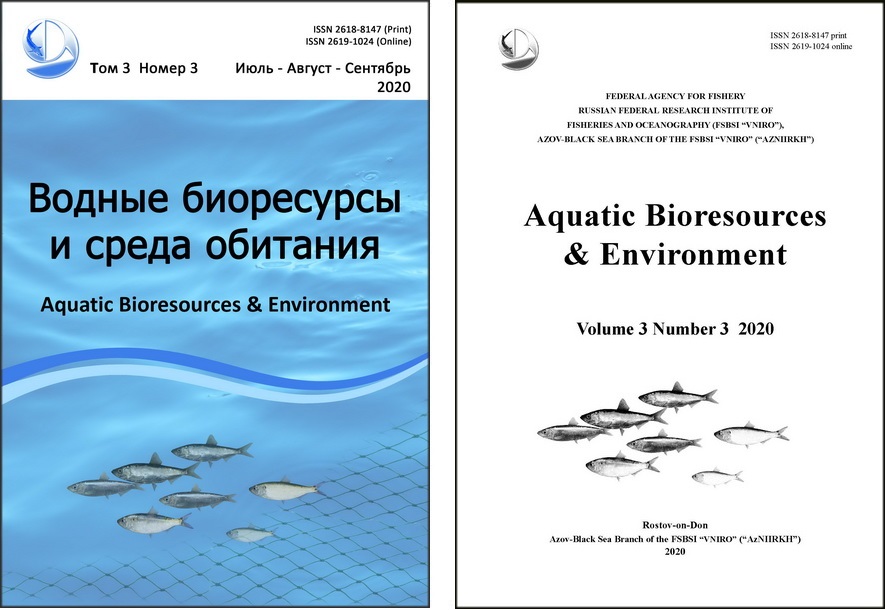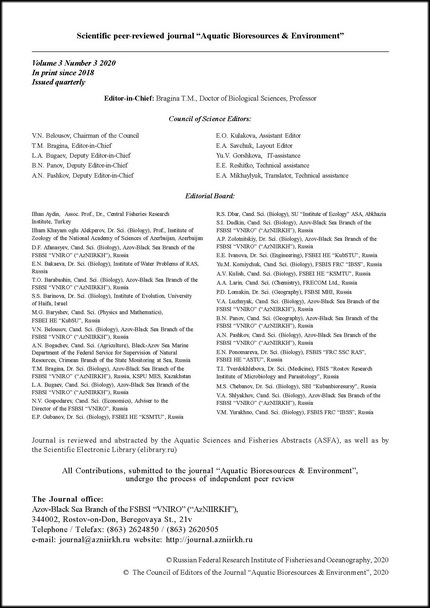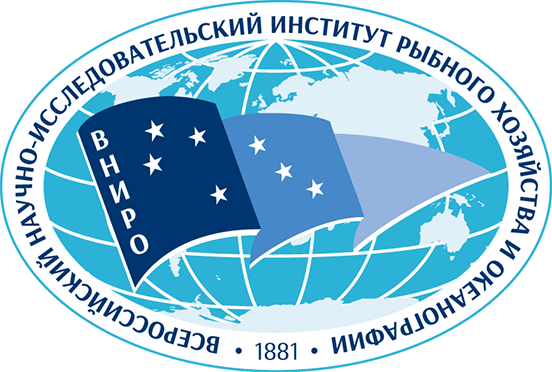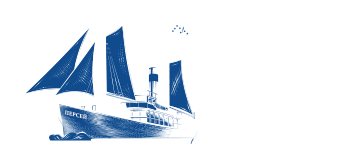

Environmental Concerns and the State of Aquatic Environment
Assessment of water and bottom sediment pollution with heavy metals and arsenic in the Caucasus Region of the Black Sea at the present time.
Evseeva A.I., Korablina I.V., Gevorkyan Zh.V., Katalevsky N.I., Gorgola L.G.
Abstract. The content of nine heavy metals (Fe, Mn, Zn, Cr, Cu, Pb, Cd, Hg, Ni) and arsenic in the water and bottom sediments of the North-Eastern Black Sea at the present time (2018–2019) has been estimated, and the results of this investigation are presented. The analyses of samples, collected during the multi-purpose expeditions of the Azov-Black Sea Branch of the FSBSI “VNIRO” (“AzNIIRKH”) in the spring – early summer and summer
– early autumn seasons, are summarized. Altogether, 204 water samples and 60 bottom sediment samples have been collected. Estimation of mass concentrations of heavy metals and arsenic has been conducted according to the methods, developed and adopted by the Azov-Black Sea Branch of the FSBSI “VNIRO” (“AzNIIRKH”). Pollution levels in the habitat of aquatic living resources have been assessed based on the standards for maximum allowable concentrations (MAC) of harmful substances in water bodies of fisheries importance and on the average long-term values. In some areas, subjected to the increased anthropogenic pressure, exceedance in MAC of iron, manganese, zinc, and nickel is recorded. It is shown that, at present, the revealed content of heavy metals and arsenic in the water and bottom sediments of the investigated area of the Caucasus Region of the Black Sea does not pose a threat for the aquatic living resources.
Keywords: Black Sea, marine pollution, aquatic environment, bottom sediments, heavy metals, arsenic, concentration
Specific features of the change in the statistical characteristics of the horizontal structure of the salinity field of the Azov Sea waters.
Panov B.N., Spiridonova E.O.
Abstract. The work is based on the data from 49 spring, summer and autumn oceanographic surveys carried out by the Azov-Black Sea Branch of FSBSI “VNIRO” (“AzNIIRKH”) in the Azov Sea from 2001 to 2016. As characteristics of the horizontal structure of the salinity field, the radii of the concentration region of the spatial correlation function of the field in the zonal and meridional directions in the surface and bottom horizons were calculated, as well as their ratio reflecting the prevailing direction of water exchange. The average size of meridional radii was 42 km, and for the zonal one it was equal to 46 km. It is shown that, in the surface layer, the radii are maximum in summer and minimum in spring; in the bottom layer they decrease mainly from spring to autumn. The zonal radius prevails in the surface layer of the sea, whereas the meridional one prevails in the bottom. In the trends of long-term changes in the surface layer, the sizes of the meridional radii have increased. In the bottom layer, the zonal radii were decreasing. The years of predominance of zonal radii in the structure of the salinity field were attended with a decrease in the average salinity of the sea, and the predominance of meridional radii was associated with its increase. An almost complete absence of statistically significant relationships between the characteristics of the field, both in seasonal and in average annual values, was noted.
Keywords: Azov Sea, salinity field, horizontal structure of the field, correlation function, water exchange, salinity increase
Dynamics of water quality in the Temernik River considering the toxicity levels based on the data of the biotest battery
Bakaeva E.N., Taradayko M.N., Ignatova N.A., Zaporozhtseva A.Yu.
Abstract. The urbanized section of the Temernik River (Rostov-on-Don, Southern Federal District) is subjected to anthropogenic pressure. During the investigation of water toxicity by means of the bioassay method, an obvious disadvantage of using one biotest was revealed. Recently, a biotests battery has been used. However, assessing toxicity based on only one, most sensitive biotest, is untenable. The toxicity assessment has been carried out according to the scale developed by the authors. The scale considers the results of the assessment of toxicity level according to each biotest, and classifies water quality in concordance with the classes adopted in hydrochemistry. The water quality of the Temernik River has been assessed by means of the bioassay method according to a set of practices, taking into account the toxicity levels for each of the applied biotests. The studies were carried out in 2017–2019. The cultures of Chlorella vulgaris, Raphanus sativus (phytotest), and Daphnia magna were used. The water of the Temernik River showed a wide range of toxicity from “low” toxic (2 “a” class) to “extremely” toxic (5 class). The dynamics of water quality was characterized by the increase in toxicity from 2017 to 2019. The highest degree of water toxicity was recorded at the mouth of the Temernik River, in the Don River downstream from the mouth of the Temernik River, and near the Botanical Garden of the Southern Federal University at the storage site for extracted bottom sediments. Biotest data are confirmed by the analytical data on water pollution.
Keywords: river water, biotest battery, phytotest, Chlorella vulgaris, Daphnia magna, final toxicity, toxicity level, water quality class
Biology and Ecology of Aquatic Organisms
Assessment of caesium-137 accumulation in the bottom sediments and aquatic bioresources of the Azov Sea at the present time.
Mkhitaryan I.D., Korablina I.V.
Abstract. The results of radioecological investigation of the bottom sediments in the Azov Sea are given for 2017–2019. Pollution of the Azov Sea bottom sediments during the period under study has been detected sporadically and is determined by redistribution of predominately post-Chernobyl fallout. The level of caesuim- 137 pollution of the bottom sediments has been evaluated in comparison with its long-term average values. The results of monitoring of radiocaesium content in the main commercial fish species of the Azov Sea are presented for the same period. Comparison of caesium-137 content in the fish muscle tissues according to the sanitary and epidemiological regulations and standards, currently in force in the Russian Federation, is made. It is shown that the content of caesium-137 in the aquatic biological resources of the Azov Sea is much lower than the maximum permissible content of this isotope in fish and does not pose a radiation threat. For the investigated period, the state of the Azov Sea environment in terms of radiation does not give cause for concern pertaining to the accumulation of caesium-137 isotope. Radioecological monitoring of the Azov Sea area in 2017–2019 has revealed that Chernobyl trace remains the main source of radiation pollution.
Keywords: caesium-137, bottom sediments, marine fish, Azov Sea, specific activity
Status of the Chamelea gallina and Pitar rudis communities in the North-Eastern Black Sea in the autumn of 2019
Frolenko L.N., Zhivoglyadova L.A.
Abstract. Spatial distribution and quantitative characteristics of the main bottom communities in the North- Eastern Black Sea, characterized by the prevalence of the native bivalve species Chamelea gallina and Pitar rudis, have been considered for the autumn season of 2019. Within the investigated region, at the depth of 18 m, the largest area of sandy biotopes with silt and shell admixture was occupied by a community dominated by the bivalve mollusc Ch. gallina. At the depth of 30 m, a community of the pelophilic bivalve mollusk P. rudis was observed on silty substrate with shells and, at times, sand admixture. In the Chamelea community, molluscs were the most prominent group in terms of abundance and biomass. In the Pitar community, polychaetes were the most abundant in the benthic community, while molluscs prevailed in terms of their biomass. If compared with the data of the 1960s, the contemporary analysis of the materials presented indicates a decrease in the biomass of the macrozoobenthos down to 93 g/m2 and of the dominant species down to 41 g/m2 in the Chamelea community, which is associated with the predominance of small individuals in the mollusc populations. In the autumn of 2019, despite the appearance of invading species, the native species prevailed in the main regional biocoenoses.
Keywords: aquatic community, species composition, spatial distribution, abundance, biomass, bivalves, Pitar rudis, Chamelea gallina, Anadara kagoshimensis, polychaetes, invading species
Characterization of the allometric growth of soft-shell clam (Mya arenaria Linnaeus, 1758) in the Southern Azov Sea
Zolotnitskiy A.P., Sytnik N.A.
Abstract. Allometric growth in the soft-shell clam, or sand gaper (Mya arenaria L.) population, inhabiting the Southern Azov Sea, is investigated. Quantitative characterization of relationship between the height (H, mm), depth (D, mm) and length (L, mm) of the shell of this mollusc, as it is based on the equations of linear (Y=a+b·X) and power (Y=a·Xb) functions, is presented. Shell shape parameters in the process of soft-shell clam growth, namely, elongation (H/L), and sagittal (D/L) and frontal (D/H) curvatures, have been studied. The relationship between mollusc length and its live body weight (W, g) is identified; it is approximated by a power function with the coefficient of proportionality (a) 1.64·10-4 and the coefficient of regression (b) 2.90. By means of the linear function, the new data on the relationship between shell weight (Wr), wet (Wm) and dry (Ws) weight of soft
tissues, liquid held in the mollusc mantle (Wmj), siphon weight (Ws) and the total (live body) weight of soft-shell
clam have been obtained. It is shown that several morphological characteristics of this species inhabiting the Azov Sea are similar in terms of their parameters to the ones of soft-shell clam populations in the White and Baltic Seas, although there exist certain distinctions.
Keywords: Mya arenaria, length, height, depths, shape parameters, live body weight, shell, soft tissue, siphon, mantle liquid
Fisheries and Processing of Aquatic Bioresources
Esina L.M., Gorbenko L.A.
Abstract. Technological standardization of the product yield after processing of aquatic bioresources is conducted to facilitate their rational management and the control over their exploitation; it also provides the means to plan out the product output and consumption of raw materials. At present, the standards for wastes, losses and meat yield are absent for the processing of a major fishing target in the Azov and Black Sea Fishery Basin, namely, veined rapa whelk Rapana venosa. In this article, the results of development and control work on standardization of wastes, losses and meat yield for veined rapa whelk, conducted in the processing environment and in the laboratory setting, are presented. The yield of veined rapa whelk meat was assessed as a proportion of the total weight of raw material incoming for processing. It is shown that the meat yield depends on the month when veined rapa whelk was harvested. The highest yield was recorded for May and June; in July and August, a decrease in the yield of veined rapa whelk meat was observed, which resulted from the growth of egg cases on the mollusc shell. For the individuals, on which shells egg cases are absent, or have been removed, a unified standard of meat yield for the entire course of harvesting season should be adopted. The meat yield for the individuals, which shells have not been cleaned of egg cases, is recommended to be regulated separately. A relation between meat yield and shell length has not been found. Statistical analysis of the data obtained on the yield of veined rapa whelk meat has shown their adherence to the law of Gaussian distribution.
Keywords: Rapana venosa, veined rapa whelk, shell, veined rapa whelk meat, processing, wastes, losses, meat yield, technological standardization, deep chilling, development and control work
Informational Messages
Advisory Board Meeting of the Aquatic Sciences and Fisheries Information System (ASFIS, FAO, 10–14.08.2020)
Bragina T.M., Kulakova E.O.
Abstract. The international information system ASFIS (Aquatic Sciences and Fisheries Information System) involves services on abstracting and indexing of publications on aquatic sciences, technology, fisheries management, and aquatic resources and environment conservation, as well as their socio-economic and legal aspects. The Annual ASFA Board Meeting (ASFA — Aquatic Sciences and Fisheries Abstracts) was held in the online format from 10 to 14 August, 2020. A wide range of issues was offered for the discussion, including the Annual FAO Secretariat Report: Partnership Agreement, progress reports of the Working and Discussion Groups, Partners' presentations, problems of the informational behavior of college students under conditions of the COVID- 19 pandemic, scientific communication during the pandemic based on the approaches and expertise of the international non-profit organization World Fish, summary of the AGROVOC Vocabulary activities (the principal controlled vocabulary of the Food and Agriculture Organization, FAO UN headquarters in Rome, Italy), as well as the issues of preparation to the ASFA 50th Anniversary in 2021.The National ASFA Partner of the Russian Federation is the Russian Research Institute of Fisheries and Oceanography (VNIRO, Moscow). The Azov- Black Sea Branch of the FSBSI “VNIRO” (“AzNIIRKH”) has long been one of the Russian Collaborating Centers dealing with abstracting and indexing of publications from the journal “Aquatic Bioresources & Environment” into the ASFA database with mandatory full text links to the open access e-repository OceanDocs.
Keywords: FAO, ASFA, ASFA Board Meeting, VNIRO, AzNIIRKH, databases, metadata, open access


